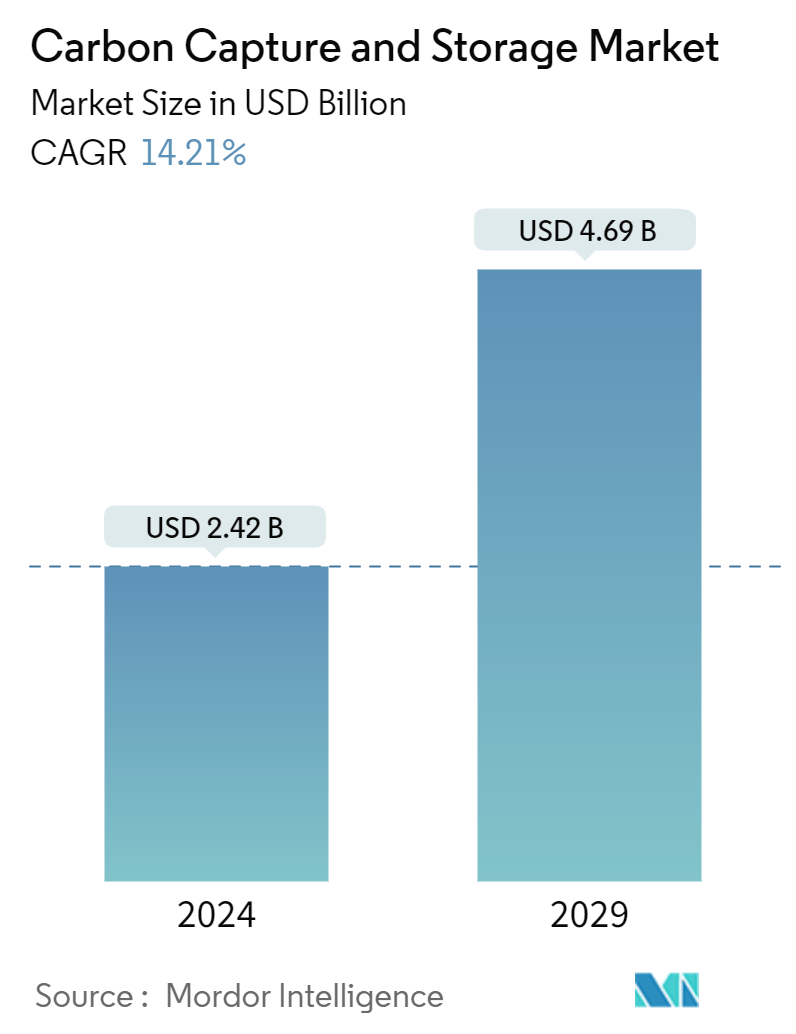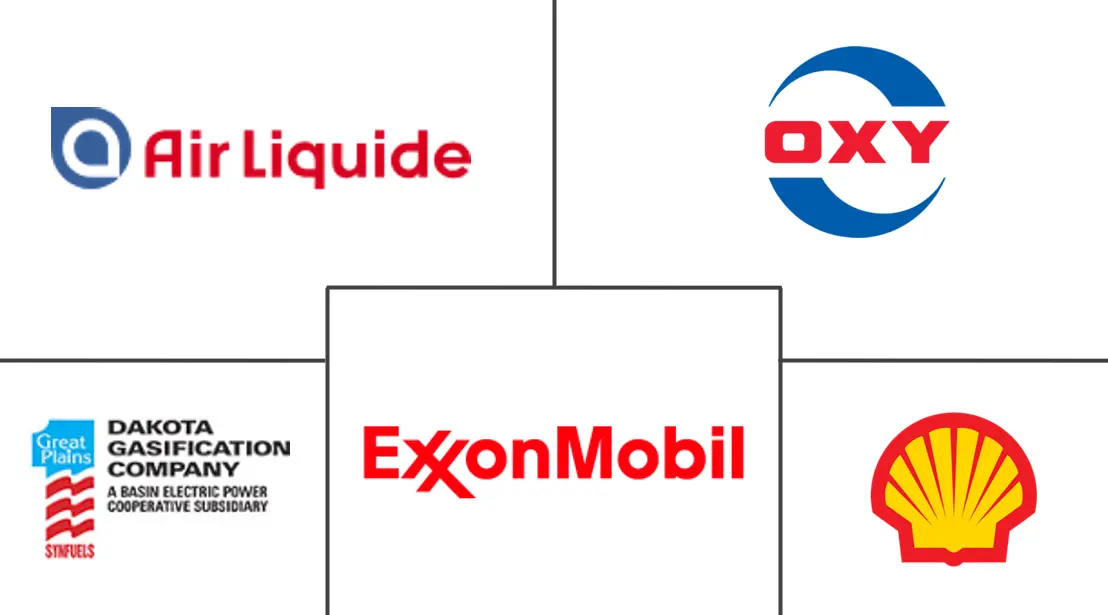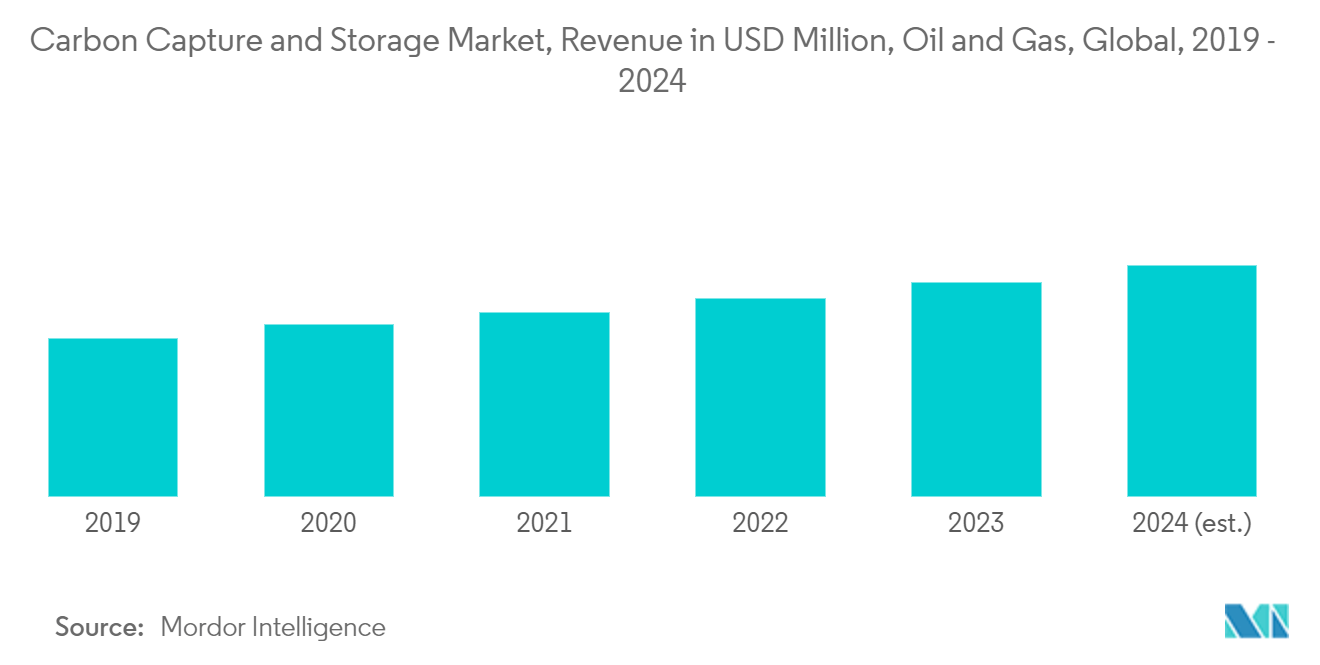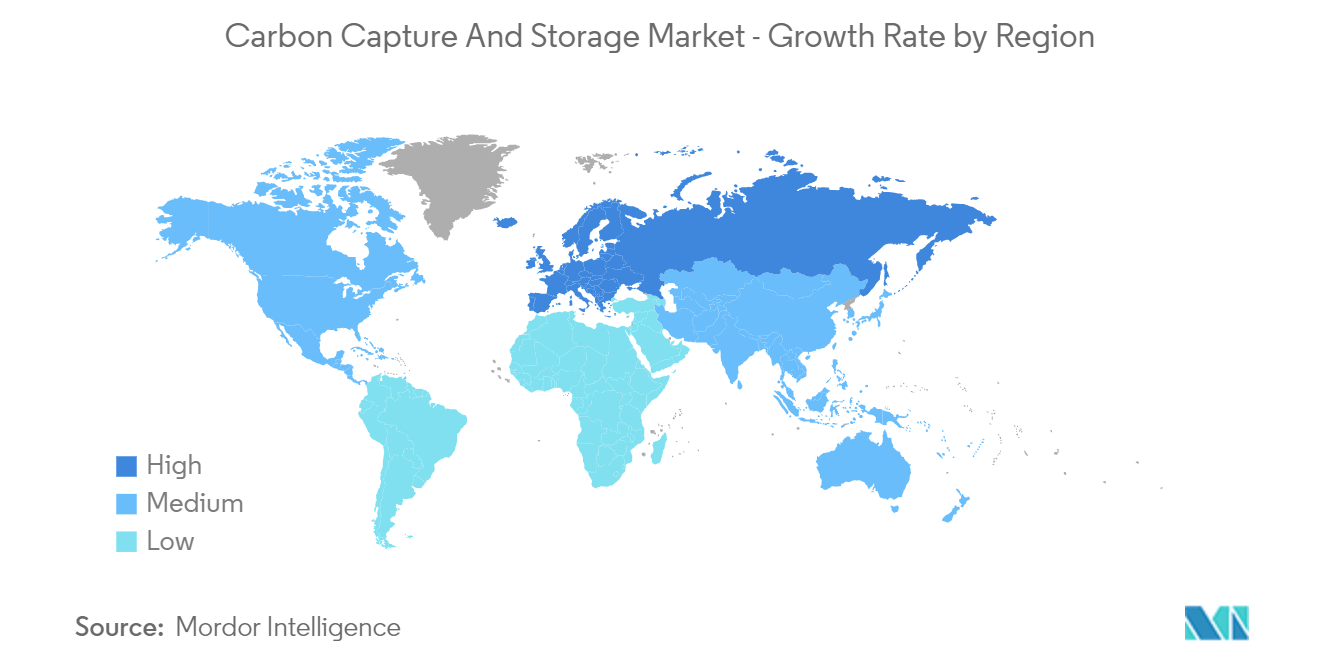Carbon Capture and Storage Market Size

| Study Period | 2019 - 2029 |
| Market Size (2024) | USD 2.42 Billion |
| Market Size (2029) | USD 4.69 Billion |
| CAGR (2024 - 2029) | 14.21 % |
| Fastest Growing Market | Europe |
| Largest Market | North America |
Major Players
*Disclaimer: Major Players sorted in no particular order |
Need a report that reflects how COVID-19 has impacted this market and its growth?
Carbon Capture And Storage Market Analysis
The Carbon Capture And Storage Market size is estimated at USD 2.42 billion in 2024, and is expected to reach USD 4.69 billion by 2029, growing at a CAGR of 14.21% during the forecast period (2024-2029).
- The major factors driving the carbon capture and storage market are the emerging demand for CO2 injection techniques for enhanced oil recovery (EOR) and strict government norms toward GHG emissions.
- On the flip side, huge CCS technology implementation costs and increases in shale investments are expected to hinder the market's growth.
- Augmenting prominence for bioenergy carbon capture and storage (BECCS) is likely to be an opportunity in the future.
- North America is likely to dominate the market, and it is expected to remain in a dominant position over the forecast period, owing to the increasing implementation of technology, mainly in the United States and Canada.
Carbon Capture And Storage Market Trends
Oil and Gas Segment to Dominate the Market
- Carbon dioxide stored in deep, onshore, or offshore geological formations uses CCS technologies for enhanced oil recovery that have been developed in the oil and gas industry.
- Carbon dioxide is extensively used in the oil industry for enhanced oil recovery (EOR) from mature oilfields. When carbon dioxide is inserted into an oilfield, it can mix with the crude oil, triggering it to swell and drop its viscosity, helping to maintain or raise the pressure in the reservoir. The combination of these processes permits more crude oil to flow to the production wells.
- In other circumstances, the carbon dioxide is not soluble in the oil. Here, the injection of carbon dioxide raises the pressure in the reservoir, helping to sweep the oil toward the production well.
- For more than three decades in Texas (United States), carbon dioxide has been used in enhanced oil recovery projects. EOR constitutes over 20% of total oil production, and some fields achieve recoveries of nearly 70%.
- Moreover, as part of sustainable development, the oil and gas industry is moving toward carbon capturing and storage technologies.
- According to the International Energy Agency (IEA), global energy-related CO2 emissions from oil and gas grew by 2.5% or 268 million tons (Mt) in 2022, reaching over 11.2 gigatons (Gt).
- Methane from energy combustion, leaks, and venting represented another 10%, mostly from onshore oil and gas operations and steam coal production. Methane emissions rose to nearly 135 Mt CH4 or around 4 Gt CO2-eq in 2022 despite high natural gas prices that increased the cost-effectiveness of methane abatement technologies.
- Therefore, public sector oil and gas companies in India are actively embracing emission-reduction strategies such as Carbon Capture, Utilization, and Storage (CCUS) as India targets net zero by 2070.

North America is Likely to Dominate the Market
- North America dominates the global carbon capture and storage market. The growing demand for clean technology, accompanied by the growing use of CO2 in EOR practices, is likely to drive the CCS market in countries like the United States and Canada.
- Chemical production, hydrogen production, fertilizer production, natural gas processing, and power generation are among the industries in the United States where CO2 is captured and injected. These facilities capture and inject CO2 to store it underground in geologic formations or to use it to boost oil production from aging oil fields, a process known as enhanced oil recovery (EOR).
- According to the Congressional Budget Office of the federal government of the United States, as of 2023, the country has about 15 operating CCS facilities, with the majority of these located at plants that process natural gas or produce ethanol for fuel or ammonia for fertilizer.
- These 15 facilities can capture about 22 million metric tons of CO2 per year, which is about 0.4% of the total annual CO2 emissions in the United States. Furthermore, the country has about 121 under-construction or being-developed CCS facilities with a combined capacity of 134 million tons of CO2 per year.
- According to IEA, in 2023, out of the operational 22 million metric tons of CO2 per year capacity of CCS, natural gas processing/LNG accounted for the largest share of about 60% of the total capacity and was valued at 13.1 million metric tons of CO2 per year, followed by fuel transformation with a share of about 18% and capacity of 3.9 million metric tons of CO2 per year.
- Under the Infrastructure Investments and Jobs Act (IIJA), the US government allocated USD 12.1 billion for carbon management technologies, of which USD 2.54 billion is appropriated for carbon capture and storage (CCS) demonstration projects from 2022 to 2025.
- As Canada has a rich supply of coal, oil reserves, and natural gas, CanmetENERGY, Canada's leading research and technology organization in the field of clean energy, is finding ways to minimize the environmental impact of fossil fuel combustion technologies, which currently comprise a substantial portion of the Canadian energy supply. One of the options is carbon capture and storage (CCS).
- Canada has agreed to reduce emissions by 30% below 2005 levels by 2030, or approximately 200 million tonnes of carbon dioxide per year, under the UN Framework Convention on Climate Change. The combined capacity of the four major CCS projects in Canada (two operational and two in development) will be up to 6.4 Mtpa, representing 3% of the reduction needed to meet the 2030 target.

Carbon Capture And Storage Industry Overview
The carbon capture and storage market is consolidated in nature. The major players in the market (not in a particular order) include Occidental Petroleum Corporation, Exxon Mobil Corporation, Dakota Gasification Company, Shell PLC, and Air Liquide, among others.
Carbon Capture And Storage Market Leaders
Occidental Petroleum Corporation
Exxon Mobil Corporation
Dakota Gasification Company
Air Liquide
Shell PLC
*Disclaimer: Major Players sorted in no particular order

Carbon Capture And Storage Market News
- March 2024: JX Nippon Oil & Gas Exploration Corporation and Chevron New Energies, a division of Chevron U.S.A. Inc., entered into a memorandum of understanding aimed at assessing the potential export of carbon dioxide from Japan to carbon capture and storage (CCS) initiatives situated in Australia and other nations across Asia-Pacific. This agreement enhances the company's market footprint.
- March 2024: Shell and ONGC collaborated on a storage study and enhanced oil recovery (EOR) screening assessment in India, including depleted oil and gas fields and saline aquifers. This collaboration aims to develop carbon capture, utilization, and storage, or CCUS/carbon capture and storage (CCS), as an emissions mitigation tool for combating climate change and injecting carbon dioxide for geological storage and enhanced oil production from mature fields of ONGC.
- February 2024: Fluor Corporation and Chevron New Energies signed a license agreement with Fluor to use its proprietary Econamine FG PlusSM carbon capture technology to reduce carbon dioxide emissions at Chevron’s Eastridge Cogeneration facility in Kern County, California.
Carbon Capture and Storage Market Report - Table of Contents
1. INTRODUCTION
1.1 Study Assumptions
1.2 Scope of the Study
2. RESEARCH METHODOLOGY
3. EXECUTIVE SUMMARY
4. MARKET DYNAMICS
4.1 Market Drivers
4.1.1 Emerging Demand for CO2 Injection Technique for Enhanced Oil Recovery (EOR)
4.1.2 Strict Government Norms Toward GHG Emissions
4.2 Market Restraints
4.2.1 Huge CCS Technology Implementation Costs
4.2.2 Growth in Shale Investments
4.3 Industry Value Chain Analysis
4.4 Porter's Five Forces Analysis
4.4.1 Bargaining Power of Suppliers
4.4.2 Bargaining Power of Consumers
4.4.3 Threat of New Entrants
4.4.4 Threat of Substitute Products and Services
4.4.5 Degree of Competition
5. MARKET SEGMENTATION (Market Size in Value)
5.1 By Technology
5.1.1 Pre-combustion Capture
5.1.2 Oxy-fuel Combustion Capture
5.1.3 Post-combustion Capture
5.2 By End-user Industry
5.2.1 Oil and Gas
5.2.2 Coal and Biomass Power Plant
5.2.3 Iron and Steel
5.2.4 Chemical
5.2.5 Cement
5.3 By Geography
5.3.1 Asia-Pacific
5.3.1.1 China
5.3.1.2 India
5.3.1.3 Japan
5.3.1.4 Australia
5.3.1.5 Rest of Asia-Pacific
5.3.2 North America
5.3.2.1 United States
5.3.2.2 Canada
5.3.2.3 Mexico
5.3.3 Europe
5.3.3.1 Germany
5.3.3.2 United Kingdom
5.3.3.3 France
5.3.3.4 Norway
5.3.3.5 Netherlands
5.3.3.6 Rest of Europe
5.3.4 Rest of the World
6. COMPETITIVE LANDSCAPE
6.1 Mergers, Acquisitions, Joint Ventures, Collaborations, and Agreements
6.2 Market Ranking Analysis
6.3 Strategies Adopted by Leading Players
6.4 Company Profiles
6.4.1 Air Liquide
6.4.2 Aker Solutions
6.4.3 Baker Hughes Company
6.4.4 Dakota Gasification Company
6.4.5 Exxon Mobil Corporation
6.4.6 Fluor Corporation
6.4.7 General Electric
6.4.8 Halliburton
6.4.9 Honeywell International Inc.
6.4.10 Japan CCS Co. Ltd
6.4.11 JX Nippon Oil & Gas Exploration Corporation
6.4.12 Linde PLC
6.4.13 Mitsubishi Heavy Industries Ltd
6.4.14 Occidental Petroleum Corporation
6.4.15 Shell PLC
6.4.16 Siemens Energy
6.4.17 SLB
- *List Not Exhaustive
7. MARKET OPPORTUNITIES AND FUTURE TRENDS
7.1 Augmenting Prominence for Bioenergy Carbon Capture and Storage (BECCS)
Carbon Capture And Storage Industry Segmentation
Carbon capture and storage (CCS) is a technology that can capture up to 90% of the carbon dioxide emissions produced from various sources that use fossil fuels in electricity generation and industrial processes, preventing carbon dioxide from entering the atmosphere. The first stage in the CCS process is capturing carbon dioxide released while burning fossil fuels or as a result of industrial processes, such as making cement and steel or in the chemical industry.
The carbon capture and storage market is segmented by technology, end-user industry, and geography. By technology, the market is segmented into pre-combustion capture, oxy-fuel combustion capture, and post-combustion capture. The market is segmented by end-user industries into oil and gas, coal and biomass power plants, iron and steel, chemical, and cement. The report also covers the market size and forecasts for 12 countries across major regions. For each segment, the market sizing and forecasts are provided based on revenue (USD).
| By Technology | |
| Pre-combustion Capture | |
| Oxy-fuel Combustion Capture | |
| Post-combustion Capture |
| By End-user Industry | |
| Oil and Gas | |
| Coal and Biomass Power Plant | |
| Iron and Steel | |
| Chemical | |
| Cement |
| By Geography | ||||||||
| ||||||||
| ||||||||
| ||||||||
| Rest of the World |
Carbon Capture and Storage Market Research FAQs
How big is the Carbon Capture And Storage Market?
The Carbon Capture And Storage Market size is expected to reach USD 2.42 billion in 2024 and grow at a CAGR of 14.21% to reach USD 4.69 billion by 2029.
What is the current Carbon Capture And Storage Market size?
In 2024, the Carbon Capture And Storage Market size is expected to reach USD 2.42 billion.
Who are the key players in Carbon Capture And Storage Market?
Occidental Petroleum Corporation, Exxon Mobil Corporation, Dakota Gasification Company, Air Liquide and Shell PLC are the major companies operating in the Carbon Capture And Storage Market.
Which is the fastest growing region in Carbon Capture And Storage Market?
Europe is estimated to grow at the highest CAGR over the forecast period (2024-2029).
Which region has the biggest share in Carbon Capture And Storage Market?
In 2024, the North America accounts for the largest market share in Carbon Capture And Storage Market.
What years does this Carbon Capture And Storage Market cover, and what was the market size in 2023?
In 2023, the Carbon Capture And Storage Market size was estimated at USD 2.08 billion. The report covers the Carbon Capture And Storage Market historical market size for years: 2019, 2020, 2021, 2022 and 2023. The report also forecasts the Carbon Capture And Storage Market size for years: 2024, 2025, 2026, 2027, 2028 and 2029.
Carbon Capture and Storage Industry Report
Statistics for the 2024 Carbon Capture and Storage market share, size and revenue growth rate, created by Mordor Intelligence™ Industry Reports. Carbon Capture and Storage analysis includes a market forecast outlook to 2029 and historical overview. Get a sample of this industry analysis as a free report PDF download.
